Audi's new all-digital cockpit kicks gauges to the curb
Testing Audi's digital dashboard of the future
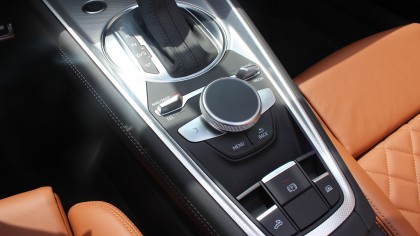
A large puck-shaped knob on the center console control panel lets you scroll through menu items. The surface of this knob actually doubles as a touchpad input device that lets you trace letters, numbers and other characters with your finger, useful for when you want to enter directions into the GPS and it's too windy for voice commands.
It's a pretty neat concept, and in my brief hands-on time, it worked reasonably well. Its character recognition was fairly spot on, but wasn't perfect. It would mistake my lower-case "T" as a plus sign ("+"), so you'll likely have to play with it to see how well it picks up your lettering.
Entering queries one character at a time can also get a little tedious, but I found the knob's surface large enough to scribble on comfortably, even without looking down, and the system was reasonably quick at recognizing letters as I traced them.
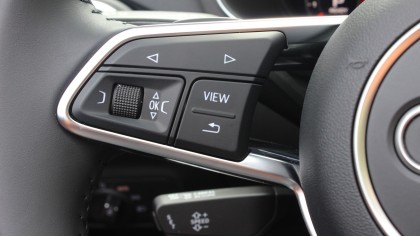
A view button on the steering wheel toggles between multiple views on the virtual cockpit, each one focusing on different content. The speedometer and tachometer are always visible, but they may appear smaller in some views to allow more space for other info. For example, if you switch to the 3D map view, the gauges will shrink, leaving you with more space for driving directions.
The speedometer and tachometer are digital renditions of mechanical instruments complete with customary red needles. Audi felt it was important to keep a more traditional feel with the gauges: it's a familiar layout, after all, and one that's easy to understand.
The physical knobs and buttons themselves feel good to the touch. They're nice and clicky, and they give plenty of tactile feedback - a must for when you're adjusting them by feel as you drive.
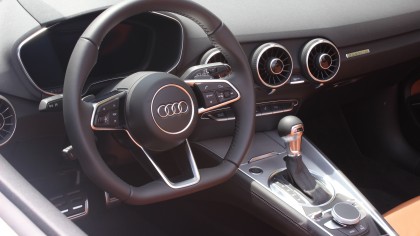
Borrowed bits
Granted, I used the system only briefly, but I found the controls to be intuitive and logically arranged. And the control system borrows heavily from existing input devices and methods.
Get daily insight, inspiration and deals in your inbox
Sign up for breaking news, reviews, opinion, top tech deals, and more.
For example, the main control knob and menu navigation reminds me a little of the clickwheel on the now-discontinued iPod Classic. Audi also borrowed the concept of left-click and right-click from the PC: pressing the "left-click" button lets you switch between various modes (switching between audio input sources, for example), while pressing the right-click button lets you get at contextual menu items.
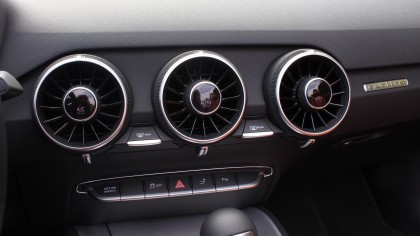
In a novel twist, the controls for the air conditioning and fan systems live on the vents themselves, which means fewer knobs cluttering up the car's main façade. This setup is reminiscent of the Nest thermostat, as you turn the circular knobs on the vents to adjust heating, ventilation and air conditioning (HVAC) settings, and press them to turn the respective systems on or off.
Small displays in center of each knob also shows the status of each HVAC function, and each of the knobs are within convenient reach of the driver. It's a clever piece of engineering and worked well enough, though the interface may take a little getting used to.

Connected drive
The 2016 Audi TT and TTS will come equipped with 4G LTE and Wi-Fi, an increasingly common feature in automobiles. Audi also included the customary voice-activated search and hands-free calling features: press the hands-free button on steering wheel, and then speak your command at the tone.
I couldn't get a good read on how well the voice recognition system worked, though, since we were out in the open in a noisy part of downtown San Francisco and it couldn't quite make out what I was saying.
As for music playback, you can listen to old-fashioned AM/FM radio, but the TT and TTS also support SiriusXM satellite radio. Alternatively, you can upload your music over the car's built-in hard drive if you like, or play music off your phone via Bluetooth. 4G LTE and Wi-Fi connectivity also mean you aren't stuck listening only to music you downloaded onto your phone - just pop open the Pandora or Spotify app and rock on.
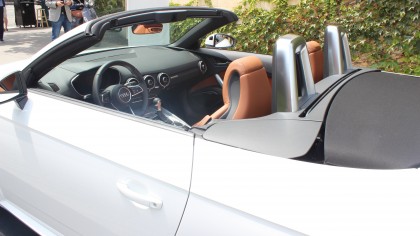
A solid first impression
Based on my initial time with it, Audi's new virtual cockpit seems like a thoughtful, well-considered addition to some sharp-looking sports cars. Granted, the real test will come when you get behind the wheel and take it for a drive, but if my first impressions are any indication, Audi has done an admirable job at simplifying in-car controls and making the driving experience that much more enjoyable.
But what about support for CarPlay and Android Auto, Apple and Google's respective automotive connectivity technologies? According to Audi's Mark Dahncke, the virtual cockpit will support CarPlay beginning with the next-generation Audi Q7, which will arrive early next year. Android Auto support will arrive at the same time as well.
If you'd like to test drive the 2016 TT and TTS, you won't have to wait long: they should arrive in dealers later this month. The TT coupe starts at $42,900 (about £27,470, AU$58,292) with the roadster starting at $46,400 (about £29,711, AU$63047). The TTS coupe starts at $51,900 (about £33,233, AU$70,521).
- Take a ride in a self-driving, autonomous car